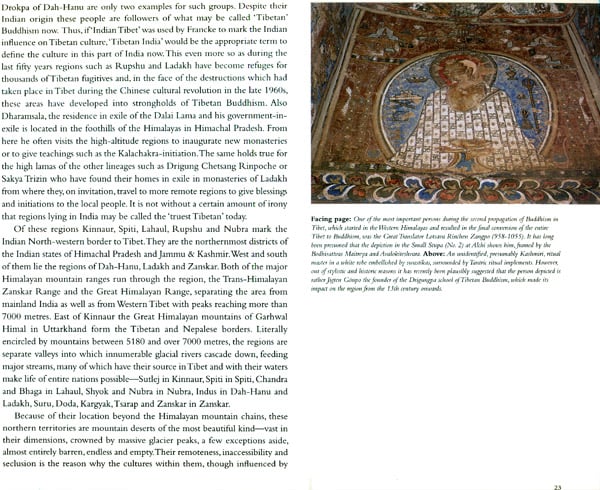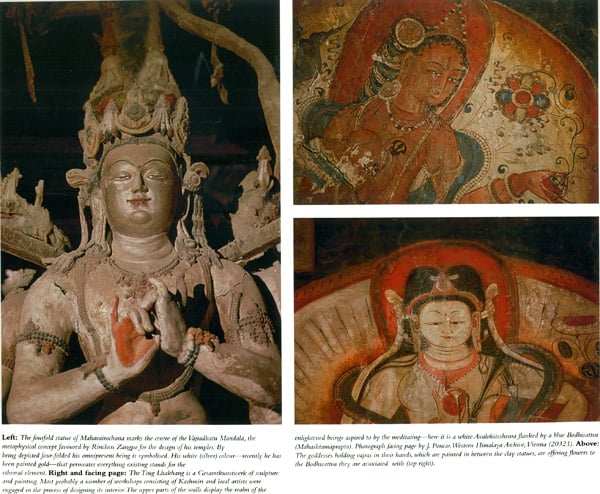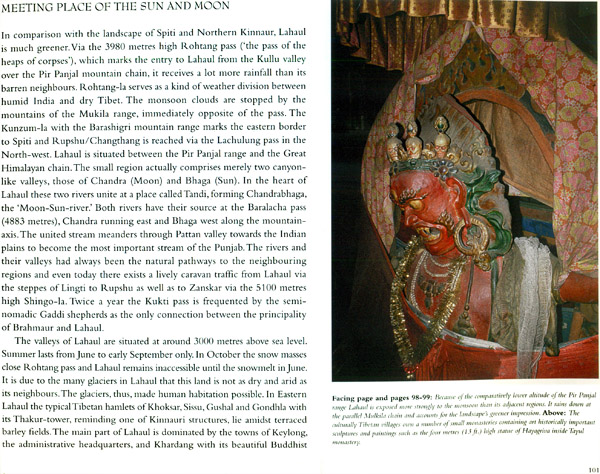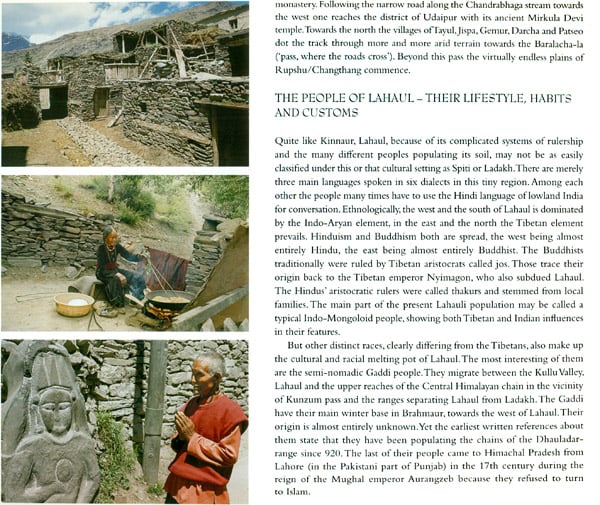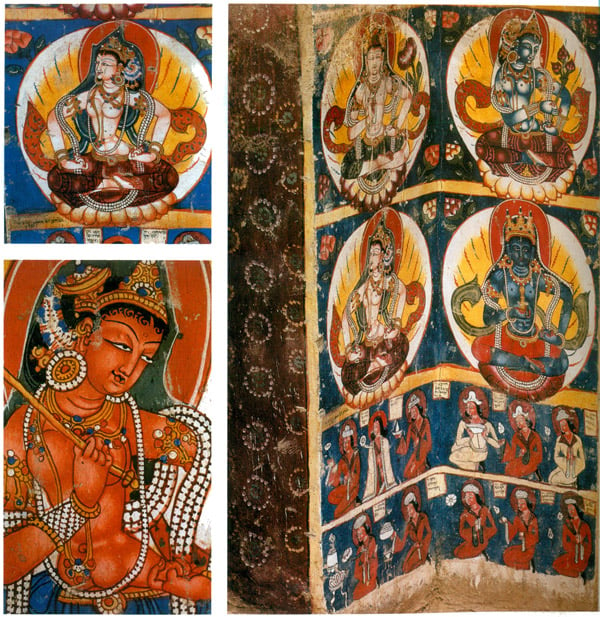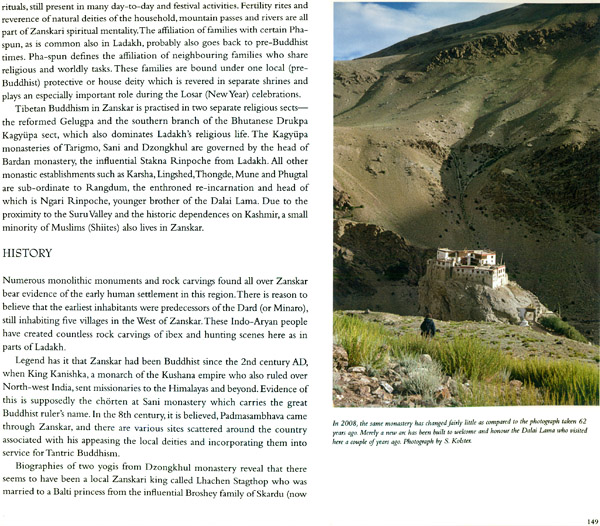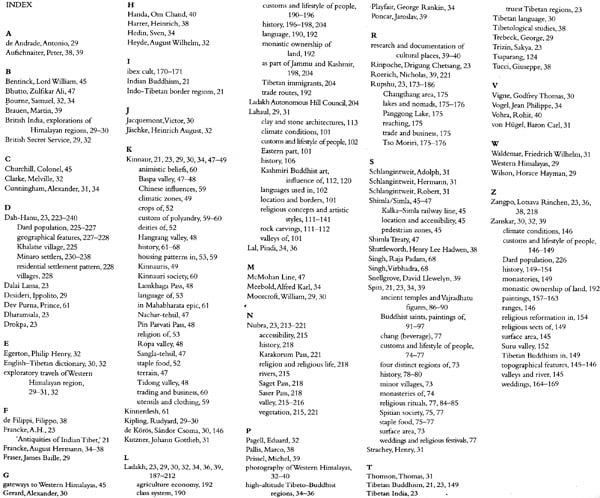
Indian Tibet Tibetan India (The Cultural Legacy of the Western Himalayas)
Book Specification
| Item Code: | NAK662 |
| Author: | Peter Van Ham |
| Publisher: | Niyogi Books |
| Language: | English |
| Edition: | 2015 |
| ISBN: | 9789383098934 |
| Pages: | 244 (Throughout Color Illustrations) |
| Cover: | Hardcover |
| Other Details | 10.0 inch x 11.0 inc |
| Weight | 1.50 kg |
Book Description
About the Book
Inspired by the first cultural expedition into the Western Himalayas by August Hermann Francke in 1909 which resulted in the region's denomination as 'Indian Tibet', Peter van Ham has travelled for years in the long inaccessible Indo- Tibetan border regions after they were opened to the public in the beginning of the 1990's.
In secluded and remote high-altitude- valleys of breath-taking grandeur he documented some of the last refuges of Tibetan and early Indian culture and photographed people and the unique testimonies of their art, religion and architecture, culturally influenced by both of the region's great neighbours-India and Tibet.
With the aid of rare archival and contemporary textual and visual materials, many seen here for the first time ever, Peter van Ham draws a comprehensive picture of the fascinating history of the exploration of the present Indian border region towards Tibet. Knowledgably he describes the customs of its various inhabitants many of whom still follow their age-old traditions which at present are being stimulated and revived by the many exiled Tibetans that have found a new home in the region, thus designating it as 'Tibetan India.'
With a message by the Dalai Lama and a preface by Michel Peissel.
About the Author
German author and photographer Peter Van Ham is an expert on Himalayan cultures and has written extensively on India's many border regions. He is a Fellow of the Royal Asiatic and the Royal Geographical Societies, London, as well as of the Explorers Club, New York. His work has been supported by the Indian Government, the Archaeological Survey of India, the UNESCO and the Dalai Lama.
Another of Peter van Ham's works published by Niyogi Books is 'ARUNACHAL-Peoples, Arts and Adornment in India's Eastern Himalayas' (2014).
Foreword
No other region of the globe has produced such a variety of cultures as the foothills and inner folds of the Western Himalayas. Peter van Ham's book is a brilliant presentation of this amazing cultural variety, the result of the interaction of all the different linguistic, cultural and religious traditions found in the Indian Himalayas.
The reason for this is that the Western Himalayas are truly the region where East and West meet. Here Indo-European languages overlap upon Tibeto- Burmese dialects and encounter, on the borders of Nubra, Turco-Mongolian dialects. Three totally distinct linguistic families intermingle here. Likewise one encounters ethnic representatives of the major racial types of both East and West. Light-eyed, long-nosed, fair-haired Minaro children live within shouting distance of Mongolian people. The cultural variety is intensified by the hundreds of microclimates found in the various valleys; many are dry deserts with a vegetation akin to that of the Siberian tundra, others, but a few miles away, may be subtropical, while in between are encountered temperate lands with Mediterranean flora.
Today we are well aware to what extent ecosystems influence local customs so that it is no real surprise that in the Western Himalayas as in the Eastern Himalayas one is confronted with so many different peoples and their varied cultures. To further complicate matters in the Indian Himalayas are found overlapping Hinduism and Buddhism resting upon an ancient but active worship of mother goddesses and goddesses of fertility of Neolithic origins.
The long time inaccessibility of these mountain regions-for both physical and political reasons-has allowed them to retain their specific characteristics longer than most other areas of the globe. How long they can keep their identity intact is a concern to all. India is keen to wean the Tibetan areas away from their origins, and it is feared that massive immigration from the lowlands into the hills could lead to a loss of identity. In the meantime it is of vital importance that the region be better known so as to assist in its preservation. This book with its clear descriptions and remarkable photographs highlighting the region's unique originality helps a great deal in this regard.
Kinnaur, Spiti, Zanskar ... I remember well how long these fascinating names aroused longing in my heart. Longing for countries, which, fairly untouched by Western influences, had supposedly kept the promise of retaining their traditional culture that for centuries had been linked to both, Tibet and India. Those regions were supposed to be the last strongholds of true Tibetan culture, and there nothing had been destroyed as gruesomely as in Tibet itself. Monasteries of a thousand years of age were supposed to retain a freshness in their concepts and art like nowhere in the world. And the landscapes- 'A world within a world ... Surely the Gods live here. This is no place for man!' as the main character of Rudyard Kipling's novel Kim had put it in the beginning of the 20th century.
In the 1980s I started trying to lay my hands on every existing page ever written about these 'Himalayan Wonderlands.' Books like Thomson's Western Himalayas and Tibet (1852), Franckes Antiquities of Indian Tibet (1914), Tucci's Indo- Tibetica (1933) or Snellgrove's Buddhist Himalaya (1957) became my dream-companions in the times of those countries' inaccessibility, because it was only in 1993 that it became possible for foreigners to travel to those formerly restricted areas of the Indian Western Himalayas. Too long had been raging the disputes between China and India about their border territories and it is thanks to the Indian military defence that these areas were excluded from the fate of mainland Tibet-the storm of the Chinese cultural revolution that had wiped out more than 6000 monasteries and had killed 1.2 million people. This terror had even reached the farthest West of Tibet where the only monasteries comparable to the cultural sites of the Northern Kinnaur, Spiti and Ladakh region-those of the Upper Sutlej river-also had to suffer the destructive brunt of small-minded Communist ideology.
None of my expectations were displeased when, after a brief visit to Lahaul in 1987, my feet touched the humid soil of Southern Kinnaur and then the barren grounds of Spiti for the first time in summer 1993, two weeks after the official opening of these areas that had been sealed-off for nearly fifty years. It was truly all still the way that the Moravian missionary and archaeologist A.H. Francke had described it for the first time ever in 1909-not much had changed, at least not in the traditionally minded mentality of the area's inhabitants. Of course there were the first satellite-antennas on the roofs of the richest Spitipa, most of the places had been brought into contact with the advantages of electricity (at least for one hour a day), but that was only natural due to the development-policies of the Big brother India. What was much more important to me was the fact that these countries had something to offer which due to the Chinese destructions had become exclusive in the Tibetan realm-a living traditional heritage in which more than 1000 years old religious concepts, rituals and beliefs were still alive, embedded into cultural sites of at least the same age. Travelling to these Western Himalayan regions was like a journey into the middle ages, in many ways back into human history.
I continued my research in the Indo- Tibetan border areas till 1998 under various topics. In 1994 and 1995 I was fortunate to be invited by the eminent Indian archaeologist O.C. Handa to join him in the exploration of the art and architecture of the most ancient monasteries of Kinnaur and Spiti, resulting in a detailed survey of Tabo, Lhalung, Dhankar, Nako and Poo. In 1997 I returned for a second continuous investigation of the area from Shimla up to Leh in Ladakh, including the recently opened regions of Nyoma/Rupshu with its magnificent high-altitude lakes as well as the Nubra valley north of the Ladakh chain, and in 1998 advised a TV-team for a documentary on Kinnaur and Spiti focussing on the life and achievements of the Great Translator Lotsava Rinchen Zangpo. These explorations were blessed by the support of His Holiness, the Dalai Lama, whom I was privileged to meet personally thrice in my life. Furthermore, the UNESCO supported my research as did the Venerable Lochen Tulku, 19th reincarnation of Lotsava Rinchen Zangpo.
After these seven expeditions I intensified my exploratory focus on the North-east of India with the manifold cultures of its seven states there. Despite the onset of a larger degree of tourist influx in the border areas of Himachal Pradesh and Jammu and Kashmir, the Western Himalayas continued to interest and fascinate me nevertheless and I continuously remained curious to receive information and new research results from there. Now, ten years after my last personal venture into 'Buddha's Mountain Desert,' I, in connection with the present book and the exhibition accompanying it, have travelled back to North-western India, this time to Ladakh, Zanskar and the Dah-Hanu region. Next to again gaining mines of new information, returning there was also a great emotional experience and brought back memories of how much the Western Himalayas have changed my life, enriching it and giving it an entirely new meaning and direction.
I developed the idea of creating a book which gives a comprehensive yet intense overview of the history and the similarities and specialities of the manifold cultures of the Western Himalayas. The opportunity of doing so came when, in co-operation with the Museum of History and Anthropology, St. Gallen, the Heinrich-Harrer-Museum, Huttenberg and the Kern Institute of Leiden University, Netherlands, the concept of an exhibition on the Western Himalayas was developed in 2007. Being granted access by the Kern Institute to the wonderful photographs taken by Babu Pindi Lal on the Francke expedition through the Western Himalayas in 1909 which had accompanied me on all of my journeys, being able to work with the masterpieces by Samuel Bourne from the Siegert Collection taken in 1866 and given the opportunity to use those of Heinrich Harrer taken in the mid-1970s shortly after Ladakh had been opened for tourists seemed as a great opportunity to create a visual representation of the Western Himalayas over a period of almost 150 years. At the same time it became possible to reproduce in good quality photographs of eminent meaning, both, in terms of cultural history and aesthetic appeal, which had been published only once and a long time back, and compare them with contemporary impressions. In this regard I am very much grateful to Gerda Theuns de Boer, art historian and then Project Manager of the Photographic Database on Asian Art and Archaeology, Kern Institute, Leiden University, the Munich-based collector Dietmar Siegert as well as Rudolf Schratter and Carina Harrer for their enthusiastic co-operation in this matter.
Luckily there are also a number of other specialists around whose photographic archives contain treasures which I on all of my seven journeys had not been able to raise. One of them is the renowned art historian Michael Henss from Zurich who had furnished detailed photographic records of the interiors of many ancient Ladakhi monasteries when this was still possible. Many of his extraordinarily beautiful pictures are shown in this book for the first time ever. I am very much grateful for his involvement in this project.
The wish to give the best possible credit to the Western Himalayan people, their environment and cultural efforts had been the motivation for the choice of pictures and the subjects to be covered in the present oeuvre. Moreover, I have tried to present in this book also rather less known cultural aspects, or, if the aspect is fairly well known, present it in a different way, e.g., through photographic views which are artworks in themselves involving perceptions which differ from what had been shown before. In this connection mention has to be made of the still highly restricted region of Dah-Hanu and its fascinating Indo-Aryan inhabitants, the comprehensive visual representation of which due to the tense political circumstances there became possible only through the generous contribution of the late Indian anthropologist Rohit Vohra who continuously had worked among these people from as far back as 1979. My sincere gratitude for this.
Looking at everything I have read on the Himalayas nothing has ever touched me more than the books written by the French anthropologist and explorer Michel Peissel. His work on the Nepalese kingdom of Mustang published in 1969 is certainly the book which has brought me to the Himalayas. It was always his comprehensive and holistic style of writing which I had admired and which to me had always come closest to what the ultimate experience one can gain from a stay in the Himalayas can be. To receive a foreword from this great person, whom I place among this century's last true explorers such as Christoph von Furer-Haimendorf, Heinrich Harrer or David Snellgrove, raises my humble efforts beyond words. Heartfelt thanks for this, even more so as this foreword was Michel's last written effort before he, sadly enough, passed away much too soon.
Without the help of a great number of people this book would not have been possible. Clearing all obstacles along the way was my old friend Mohit Sharma and his family as well as his magnificent team of Great Himalayan Travels at Shimla with the late Pema Dorje, Pardeshi, Bhablu, Lekraj and Kiran, being always completely devoted to my tasks. In Ladakh I can imagine no travel company to serve one better than Tsering Angchuk's Great Global Expedition whose fantastic service I want to recommend as wholeheartedly as I would like to thank Tashi Samphel Kangchen for his friendship and excellent treatment during our tour.
To my fatherly friend, the great Indian archaeologist O.C. Handa, I will always be thankful for his concern, interest and care in every respect.
In India I am deeply indebted to the religious leaders of the region, foremost His Holiness, the Dalai Lama, who has wholeheartedly supported my efforts in my quest for knowledge, and His Eminence, Lochen Tulku, Kye; the Venerable Ones-the late Geshe Sonam Wangdui of Tabo monastery; the Karsha Lonpo Sonam Wangchuk and his son Wangchuk; Lama Nodrup of Tungri Village; the abbot of Bardan Monastery, Lopon Rigdzin Dedan; Khentul Rinpoche, Dhankar; Geshe Sonam Angrup, Lossar; Lhakdor from the Dalai Lama's office, as well as all the monks ofTabo, Lhalung, Kye, Kanum and Bardan. A heartfelt thank-you also to the many lay-people, the friends and supporters of my quests, especially the King of Zangla, Gyalses Nima Norbu Namgyal De, and his wife Tsering Chokit Wangmo and son Jigmet Dawa Stambey Nima Chogla; amchi TseringTashi Labu, Hansa; O.P. Negi Dewa and his father, the Venerable Lama of Pooh; Ashwani Kapur, Director of Tourism and Civil Aviation, Shimla; Ranjeet Singh Negi and his family, Nako.
For their travel companionship I wish to thank Sidonia Kolster, Tina Radke- Gerlach. Josef Wormann. Volker Weber, Aglaja Stirn, O.C. Handa and Andreas Brix. To my parents I am grateful for the manifold and varied support of my many efforts over a period of twenty years. To Michael Beck, Gayle Dunlap, Hans Forst, Gunter Gessinger, Michael Henss, Anne D'Heygers, Sidonia Kolster, Guido Mangold, Helmut Neumann, Rohit Vohra, Volker Weber and Hans Weihreter I am grateful for their magnificent pictures. Alfonso van Hoof's amazing, selflessly provided maps were a most welcome state-of-the-art addition. Sincere thanks for these.
For giving me the opportunity to curate an exhibition on the subject of my interest and research at their premises I wish to thank Daniel and Isabella Studer of the Museum of History and Anthropology, St. Gallen, Stephan Augustin of the Museum of Anthropology, Herrnhut, Angelika Riemann of the Kreismuseum Zons, and all of their staff members. Further gratitude goes to the associated loaning institutions and their staff members for their great support of this project: Museum Rietberg, Zurich-Alexandra von Przychowski and the board of trustees; University Museum of Anthropology, Zurich-Philippe Dallais and Mareile Flitsch; Museum of Cultures, Basle- Stephanie Lovasz and the board of trustees; the British Museum, London-Michael Willis and Robert Owen. Finally, extra special gratitude goes to Ronald Gems for his extremely generous support of the overall project.
To my beloved Sidonia in deep gratitude.
Contents
| Message: The Dalai Lama | 10 |
| Foreword: Variety Endangered Michel Peissel | 11 |
| Introduction and Acknowledgements | 13 |
| Indian Tibet-Tibetan India | |
| Cultural Exchange, Cross-relations and Interactions in the Western Himalayas | 21 |
| The Exploration of the Western Himalayas | 29 |
| Shimla and Kinnaur | 43 |
| The Britons and the Fairy Land | |
| Spiti | 71 |
| Buddha’s Mountain Desert | |
| Lahaul | |
| Meeting Place of the Sun and Moon | 99 |
| Western Himalayan Buddhist Art | 111 |
| Influences, Styles, Developments | |
| Zanskar | 143 |
| Valley of the White Copper | |
| Rupshu | 173 |
| Lakes and Nomads | |
| Ladakh | 187 |
| Little Tibet of Passes | |
| Nubra | 213 |
| Dunes to Central Asia | |
| Dah-Hanu | 223 |
| Refuge of the Last Aryans | |
| Bibliography | 241 |
| Index | 244 |
